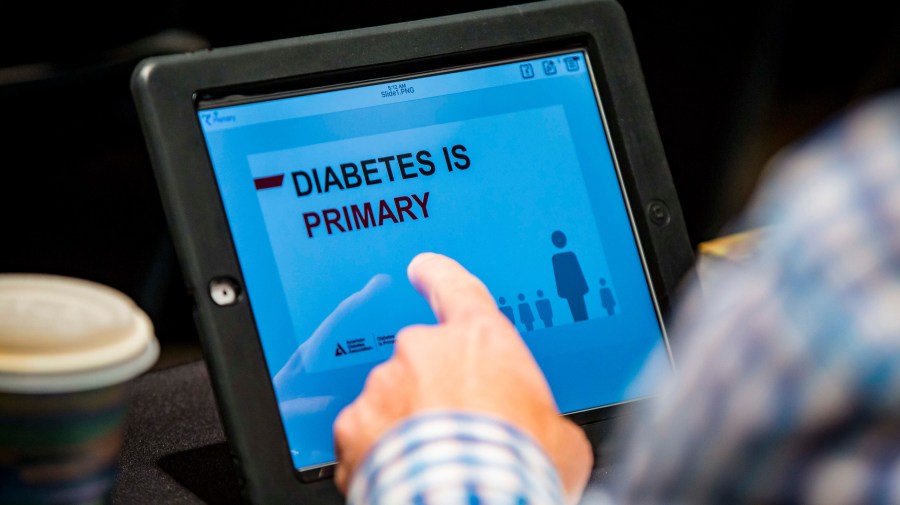What's Normal for a Blood Sugar Reading

Medical terminology can be a fleck confusing, even when the item in question is something very bones, like blood sugar. You've probably heard someone in your life talk almost their blood sugar — likewise known equally blood glucose — earlier. In truth, blood sugar levels affect everyone, not only those with diabetes. Temporary rises and falls in blood sugar can cause a host of problems, such every bit fatigue, weakness, nausea, airsickness, dizziness and headaches. Ongoing problems with blood sugar can pb to serious health atmospheric condition.
Learning about normal blood sugar levels is helpful for everyone and admittedly critical for those managing endocrine weather like diabetes or hypoglycemia. If yous're not certain what "normal" should look like, check out this guide to normal blood saccharide levels and diabetes exam range numbers.
Normal blood sugar levels vary throughout the day for everyone and are affected by the foods we swallow, the beverages we drink and the exercise (or lack of it) we get. A normal claret sugar level for a person who has not been diagnosed with diabetes should exist 80-99 mg/dL (milligrams per deciliter) when they have not eaten for more than two hours. This means there are 80-99 milligrams of glucose (a type of carbohydrate in the body) per deciliter of blood when the blood is tested.
When a person with normal blood sugar responses eats a meal, the claret saccharide will spike merely should not exceed 140 mg/dL. The exact amount of the spike will vary based on the foods that are eaten. Approximately ii hours after eating a meal, normal blood saccharide should autumn below the 140 mg/dL maximum in a person who does not have claret sugar issues. A person who has been diagnosed with diabetes or other endocrine conditions will have unlike blood saccharide levels that require close monitoring.
What Is Diabetes?
Diabetes is a disease that affects blood sugar management in the human torso. If you are diagnosed with diabetes, information technology means the amount of glucose or sugar in your blood typically remains as well high and exceeds blood sugar levels that are considered normal. This occurs when there is a problem with the insulin response in the trunk.
Insulin is created by the pancreas specifically to manage the level of glucose in the blood to ensure that sugar is transferred to the body'south cells to be used for energy. In a person who has been diagnosed with diabetes, the pancreas either doesn't make the insulin the body needs (Type 1 diabetes), or the body becomes resistant to insulin, causing regular insulin production to no longer be sufficient for controlling blood carbohydrate (Type 2 diabetes).
Types of Diabetes
Blazon 1 diabetes occurs when the pancreas stops making insulin at all or makes very little. The reasons for this even so aren't completely understood, although genetics are believed to play a role in many cases. It'due south possible to develop Type 1 diabetes at any age, but it often showtime appears in children or at a immature historic period. If you develop this type, you will have to take insulin every day to ensure carbohydrate doesn't build upward in your blood to a unsafe level. The type and frequency of insulin doses varies from person to person.
Type 2 diabetes nearly often develops in center-aged adults. The reasons the trunk develops a resistance to insulin in some people aren't fully known, but scientists have definitely linked diet and obesity to an increased risk of Type 2 diabetes. Gestational diabetes is a form of insulin resistance that occurs due to hormone changes in pregnancy. This type of diabetes usually disappears after giving birth, but it has been linked to a greater hazard of Type 2 diabetes in the future.
Monogenic diabetes and cystic fibrosis-related diabetes are two additional forms of diabetes that don't receive as much attention. Monogenic diabetes is rare — virtually 1% to 4% of cases — and usually inherited from one or both parents. Information technology occurs due to a single gene mutation. Cystic fibrosis-related diabetes merely occurs in combination with cystic fibrosis, but it affects about forty% to l% of those who have CF and shortens their lifespans.
Testing for Diabetes
If yous experience symptoms that indicate your blood saccharide is high, your doctor may investigate past ordering a serial of claret tests that include your claret glucose level at the fourth dimension of the test too as your glycated hemoglobin level. Likewise known as an A1C test, your glycated hemoglobin level provides data near your average blood sugar over a menses of two to three months. If your A1C level is above 6.five%, it could bespeak you take diabetes, specially if the results of a fasting claret carbohydrate examination and an oral glucose tolerance examination also bespeak diabetes.
Treating Diabetes
If you are diagnosed with any course of diabetes, handling begins with monitoring your blood sugar levels advisedly. Many people with Blazon 2 diabetes successfully manage their claret sugar levels with healthy dietary changes that minimize sugar and carbohydrate consumption and the addition of exercise to their daily lives. In some cases, they too have to have medication or rely on insulin replacement to manage their claret saccharide levels.
If yous have Blazon one diabetes, insulin replacement therapy is required to control the blood sugar level in your body. Replacement therapies consist of doses of insulin delivered via injections or through an insulin pump. Oral medications may exist used in combination with insulin therapy for ameliorate results, just insulin itself is not administered orally.
Resource Links:
https://www.thediabetescouncil.com/what-are-blood-sugar-target-ranges/
https://www.mayoclinic.org/diseases-conditions/diabetes/symptoms-causes/syc-20371444
https://www.ncbi.nlm.nih.gov/pmc/manufactures/PMC5826202/
https://www.niddk.nih.gov/health-data/diabetes/overview/what-is-diabetes/monogenic-neonatal-mellitus-mody
https://www.mayoclinic.org/diseases-conditions/diabetes/diagnosis-treatment/drc-20371451
https://www.cdc.gov/diabetes/managing/manage-blood-sugar.html
Source: https://www.symptomfind.com/health/what-is-normal-blood-sugar-level?utm_content=params%3Ao%3D740013%26ad%3DdirN%26qo%3DserpIndex
0 Response to "What's Normal for a Blood Sugar Reading"
Post a Comment